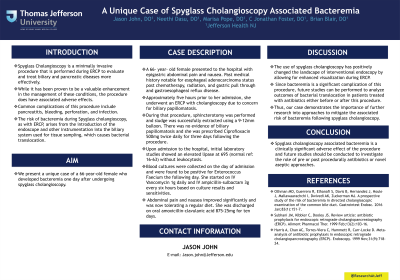Sunday Poster Session
Category: Interventional Endoscopy
P0871 - A Unique Case of Spyglass Cholangioscopy-Associated Bacteremia
Sunday, October 22, 2023
3:30 PM - 7:00 PM PT
Location: Exhibit Hall

Has Audio

Jason John, DO
Jefferson Health
Stratford, NJ
Presenting Author(s)
Jason John, DO1, Neethi Dasu, DO2, Marisa Pope, DO1, C Jonathan Foster, DO3, Brian Blair, DO1
1Jefferson Health, Stratford, NJ; 2Jefferson Health, New Jersey, NJ; 3Jefferson Health, Cherry Hill, NJ
Introduction: Spyglass Cholangioscopy is a minimally invasive procedure that is performed during ERCP to evaluate and treat biliary and pancreatic diseases more effectively. While it has been proven to be a valuable enhancement in the management of these conditions, the procedure does have associated adverse effects. Common complications of this procedure include pancreatitis, bleeding, perforation, and infection. The risk of bacteremia during Spyglass cholangioscopy, as with ERCP, arises from the introduction of the endoscope and other instrumentation into the biliary system, which causes bacterial translocation. We present a unique case of a 66-year-old female who developed bacteremia one day after undergoing spyglass cholangioscopy.
Case Description/Methods: A 66- year- old female presented to the hospital with epigastric abdominal pain and nausea. Past medical history notable for esophageal adenocarcinoma status post chemotherapy, radiation, and gastric pull through and gastroesophageal reflux disease. Approximately five hours prior to her admission, she underwent an ERCP with cholangioscopy due to concern for biliary papillomatosis. During that procedure, sphincterotomy was performed and sludge was successfully extracted using a 9-12mm balloon. There was no evidence of biliary papillomatosis and she was prescribed Ciprofloxacin 500mg twice daily for three days following the procedure. Upon admission to the hospital, initial laboratory studies showed an elevated lipase at 695 (normal ref: 16-63) without leukocytosis. Blood cultures were collected on the day of admission and were found to be positive for Enterococcus Faecium the following day. She started on IV Vancomycin 1g daily and IV ampicillin-sulbactam 3g every six hours based on culture results and sensitivities. Abdominal pain and nausea improved significantly and was now tolerating a regular diet. She was discharged on oral amoxicillin-clavulanic acid 875-25mg for ten days.
Discussion: The use of spyglass cholangioscopy has positively changed the landscape of interventional endoscopy by allowing for enhanced visualization during ERCP. Since bacteremia is a significant complication of this procedure, future studies can be performed to analyze outcomes of bacterial translocation in patients treated with antibiotics either before or after this procedure. Thus, our case demonstrates the importance of further research into approaches to mitigate the associated risk of bacteremia following spyglass cholangioscopy.
Disclosures:
Jason John, DO1, Neethi Dasu, DO2, Marisa Pope, DO1, C Jonathan Foster, DO3, Brian Blair, DO1. P0871 - A Unique Case of Spyglass Cholangioscopy-Associated Bacteremia, ACG 2023 Annual Scientific Meeting Abstracts. Vancouver, BC, Canada: American College of Gastroenterology.
1Jefferson Health, Stratford, NJ; 2Jefferson Health, New Jersey, NJ; 3Jefferson Health, Cherry Hill, NJ
Introduction: Spyglass Cholangioscopy is a minimally invasive procedure that is performed during ERCP to evaluate and treat biliary and pancreatic diseases more effectively. While it has been proven to be a valuable enhancement in the management of these conditions, the procedure does have associated adverse effects. Common complications of this procedure include pancreatitis, bleeding, perforation, and infection. The risk of bacteremia during Spyglass cholangioscopy, as with ERCP, arises from the introduction of the endoscope and other instrumentation into the biliary system, which causes bacterial translocation. We present a unique case of a 66-year-old female who developed bacteremia one day after undergoing spyglass cholangioscopy.
Case Description/Methods: A 66- year- old female presented to the hospital with epigastric abdominal pain and nausea. Past medical history notable for esophageal adenocarcinoma status post chemotherapy, radiation, and gastric pull through and gastroesophageal reflux disease. Approximately five hours prior to her admission, she underwent an ERCP with cholangioscopy due to concern for biliary papillomatosis. During that procedure, sphincterotomy was performed and sludge was successfully extracted using a 9-12mm balloon. There was no evidence of biliary papillomatosis and she was prescribed Ciprofloxacin 500mg twice daily for three days following the procedure. Upon admission to the hospital, initial laboratory studies showed an elevated lipase at 695 (normal ref: 16-63) without leukocytosis. Blood cultures were collected on the day of admission and were found to be positive for Enterococcus Faecium the following day. She started on IV Vancomycin 1g daily and IV ampicillin-sulbactam 3g every six hours based on culture results and sensitivities. Abdominal pain and nausea improved significantly and was now tolerating a regular diet. She was discharged on oral amoxicillin-clavulanic acid 875-25mg for ten days.
Discussion: The use of spyglass cholangioscopy has positively changed the landscape of interventional endoscopy by allowing for enhanced visualization during ERCP. Since bacteremia is a significant complication of this procedure, future studies can be performed to analyze outcomes of bacterial translocation in patients treated with antibiotics either before or after this procedure. Thus, our case demonstrates the importance of further research into approaches to mitigate the associated risk of bacteremia following spyglass cholangioscopy.
Disclosures:
Jason John indicated no relevant financial relationships.
Neethi Dasu indicated no relevant financial relationships.
Marisa Pope indicated no relevant financial relationships.
C Jonathan Foster indicated no relevant financial relationships.
Brian Blair indicated no relevant financial relationships.
Jason John, DO1, Neethi Dasu, DO2, Marisa Pope, DO1, C Jonathan Foster, DO3, Brian Blair, DO1. P0871 - A Unique Case of Spyglass Cholangioscopy-Associated Bacteremia, ACG 2023 Annual Scientific Meeting Abstracts. Vancouver, BC, Canada: American College of Gastroenterology.
